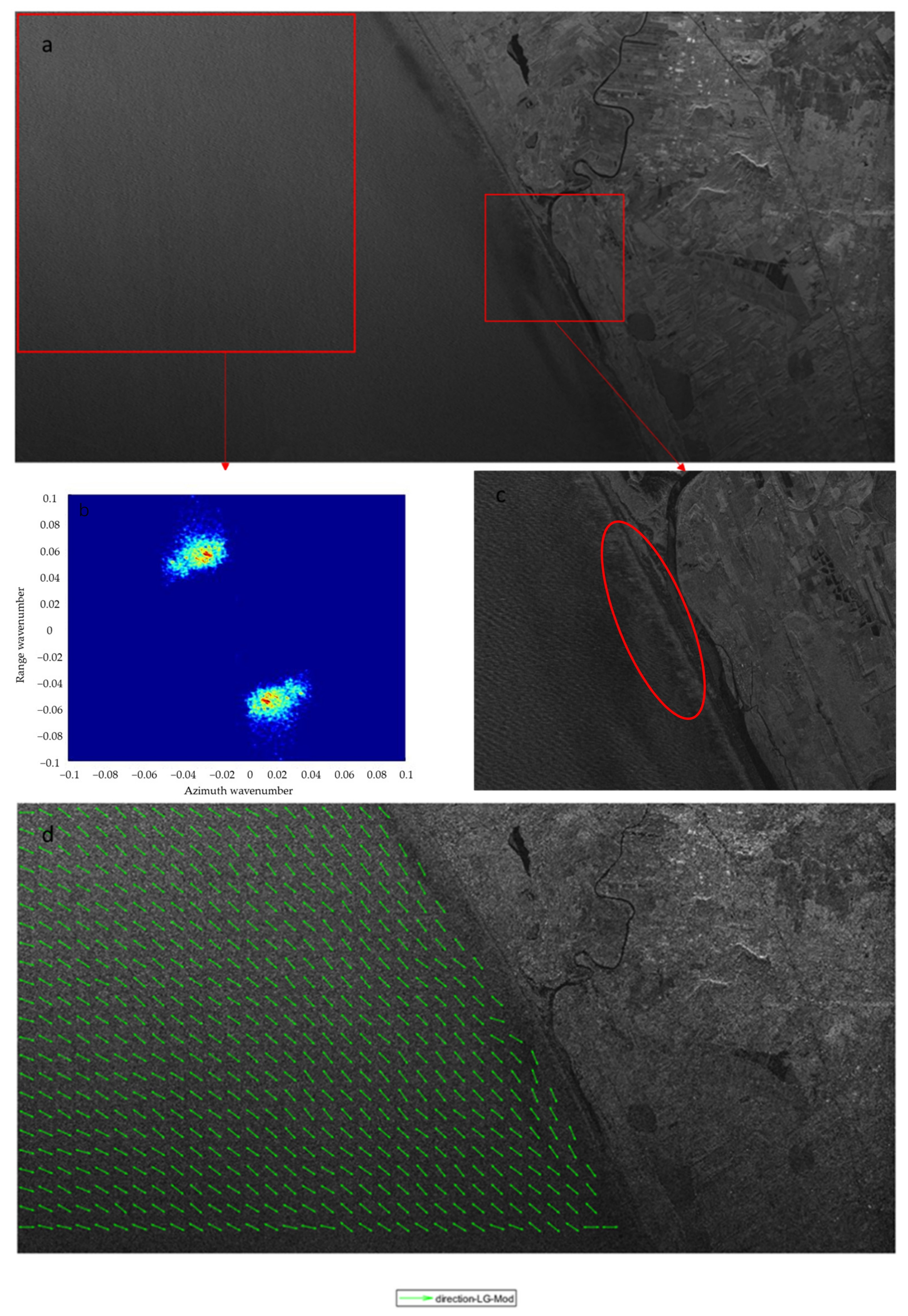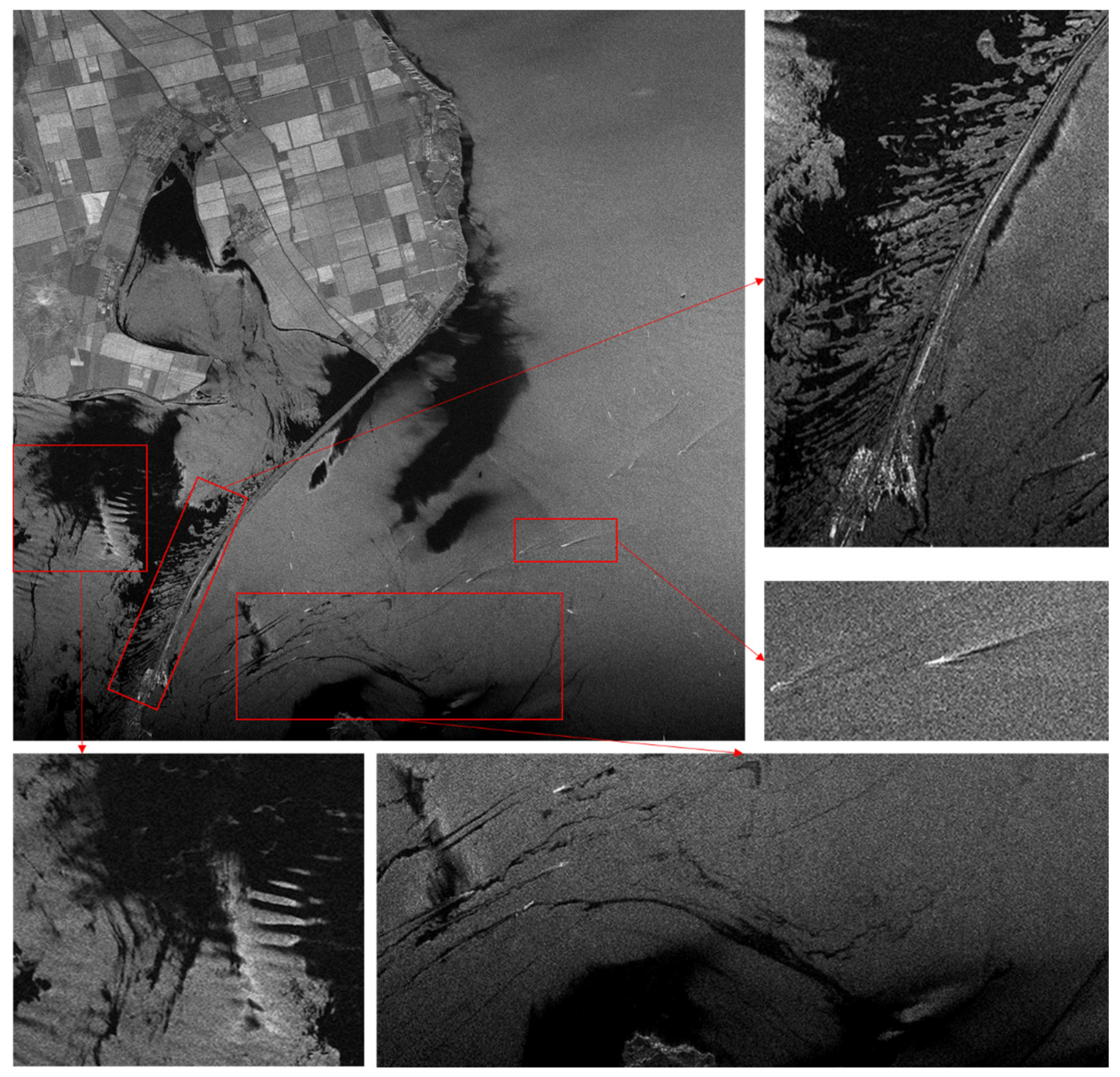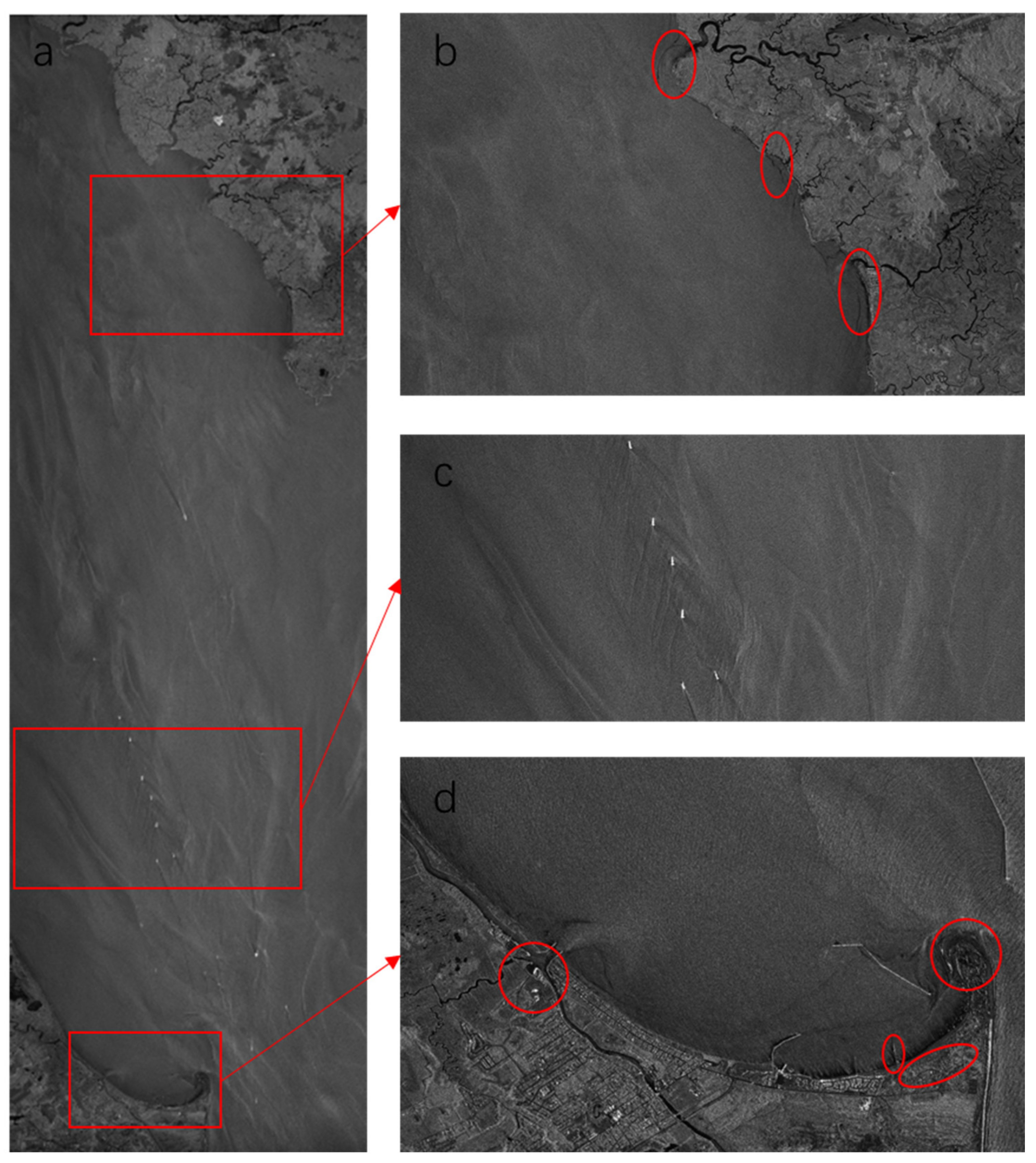HISEA-1: The First C-Band SAR Miniaturized Satellite for Ocean and Coastal Observation
Abstract
1. Introduction
2. Typical Data and Preliminary Results
2.1. Sea Ice
2.2. Ocean Wind, Wave and Rip Current
2.3. 3D Features of High Rise
2.4. Dark Spots in Image of Kerch Strait
2.5. Coastal Observation in Delaware Bay
3. Conclusions
Author Contributions
Funding
Institutional Review Board Statement
Informed Consent Statement
Data Availability Statement
Acknowledgments
Conflicts of Interest
References
- He, Y.; Zhang, B.; Perrie, W. Validation of RADARSAT-2 Polarimetric SAR Measurements of Ocean Waves. In Proceedings of the 2010 IEEE Geoscience and Remote Sensing Symposium (IGARSS), Honolulu, HI, USA, 25–30 July 2010. [Google Scholar]
- Hui, S.; Perrie, W.; He, Y.; Liu, G. Wind speed retrieval from VH dual-polarization radarsat-2 SAR images. IEEE Trans. Geosci. Remote Sens. 2014, 52, 5820–5826. [Google Scholar]
- Li, X.; Jackson, C.; Monaldo, F.; Xu, Q.; Bao, S. Application Sentinel-1 SAR Data for Ocean Research and Operation. In Proceedings of the 2016 IEEE International Geoscience and Remote Sensing Symposium (IGARSS), Beijing, China, 10–15 July 2016. [Google Scholar]
- Li, X.-M.; Zhang, T.; Huang, B.; Jia, T. Capabilities of Chinese Gaofen-3 Synthetic Aperture Radar in Selected Topics for Coastal and Ocean Observations. Remote Sens. 2018, 10, 1929. [Google Scholar] [CrossRef]
- Li, X.M.; Sun, Y.; Zhang, Q. Extraction of sea ice cover by Sentinel-1 SAR based on support vector machine with unsupervised generation of training data. IEEE Trans. Geosci. Remote Sens. 2020, 99, 1–14. [Google Scholar]
- Lin, B.; Shao, W.; Li, X.; Li, H.; Du, X.; Ji, Q.; Cai, L. Development and validation of an ocean wave retrieval algorithm for VV-polarization Sentinel-1 SAR data. Acta Oceanol. Sin. 2017, 36, 95–101. [Google Scholar] [CrossRef]
- Song, D.; Ding, Y.; Li, X.; Zhang, B.; Xu, M. Ocean oil spill classification with Radarsat-2 SAR based on an optimized wavelet neural network. Remote Sens. 2017, 9, 799. [Google Scholar] [CrossRef]
- Topouzelis, K.; Singha, S. Oil spill detection using space-borne Sentinel-1 SAR imagery. In Oil Spill Science and Technology, 2nd ed.; Fingas, M., Ed.; Spill Science: Edmonton, AB, Canada, 2017; pp. 387–402. [Google Scholar]
- Wang, H.; Yang, J.; Mouche, A.; Shao, W.; Zhu, J.; Ren, L.; Xie, C. GF-3 SAR Ocean Wind Retrieval: The First View and Preliminary Assessment. Remote Sens. 2017, 9, 694. [Google Scholar] [CrossRef]
- Wang, H.; Wang, J.; Yang, J.; Ren, L.; Zhu, J.; Yuan, X.; Xie, C. Empirical Algorithm for Significant Wave Height Retrieval from Wave Mode Data Provided by the Chinese Satellite Gaofen-3. Remote Sens. 2018, 10, 363. [Google Scholar] [CrossRef]
- Yang, J.; Wang, J.; Ren, L. The first quantitative remote sensing of ocean internal waves by Chinese GF-3 SAR satellite. Acta Oceanol. Sin. 2017, 36, 118. [Google Scholar] [CrossRef]
- Sun, J.; Yu, W.; Deng, Y. The SAR payload design and performance for the GF-3 mission. Sensors 2017, 17, 2419. [Google Scholar] [CrossRef] [PubMed]
- Shuchman, R.A.; Flett, D.G. SAR Measurement of Sea Ice Parameters: Sea Ice Session Overview Paper. In Proceedings of the Second Workshop on Coastal and Marine Applications of SAR, Svalbard, Norway, 8–12 September 2003; European Space Agency: Noordwijk, The Netherlands, 2004; pp. 151–160. [Google Scholar]
- Yu, Q. Automated SAR Sea Ice Interpretation. Ph.D. Thesis, Department of Systems Design Engineering, University of Waterloo, Waterloo, ON, Canada, 2006. [Google Scholar]
- Rana, F.M.; Maria, A.; Guido, P.; Giacomo, D.C.; Sandra, M. Lg-mod: A modified local gradient (lg) method to retrieve SAR sea surface wind directions in marine coastal areas. J. Sens. 2016, 2016, 9565208. [Google Scholar] [CrossRef]
- Hasselmann, K.; Hasselmann, S. On the nonlinear mapping of an ocean wave spectrum into a synthetic aperture radar image spectrum. J. Geophys. Res. 1991, 96, 10713–10729. [Google Scholar] [CrossRef]
- Hasselmann, S.; Bruning, C.; Hasselmann, K. An improved algorithm for the retrieval of ocean wave spectra from synthetic aperture radar image spectra. J. Geophys. Res. 1996, 101, 16615–16629. [Google Scholar] [CrossRef]
- Mastenbroek, C.; De Valk, C.F. A semi-parametric algorithm to retrieve ocean wave spectra from synthetic aperture radar. J. Geophys. Res. 2000, 105, 3497–3516. [Google Scholar] [CrossRef]
- Zhang, B.; Li, X.F.; Perrie, W.; He, Y.J. Synergistic measurements of ocean winds and waves from SAR. J. Geophys. Res. 2015, 120, 6164–6184. [Google Scholar] [CrossRef]
- Sun, J.; Guan, C.L. Parameterized first-guess spectrum method for retrieving directional spectrum of swell-dominated waves and huge waves from SAR images. Chin. J. Oceanol. Limnol. 2006, 24, 12–20. [Google Scholar]
- Schulz-Stellenfleth, J.; Lehner, S.; Hoja, D. A parametric scheme for the retrieval of two-dimensional ocean wave spectra from synthetic aperture radar look cross spectra. J. Geophys. Res. 2005, 110, 297–314. [Google Scholar] [CrossRef]
- Li, X.M.; Konig, T.; Schulz-Stellenfleth, J.; Lehner, S. Validation and intercomparison of ocean wave spectra inversion schemes using ASAR wave mode data. Int. J. Remote Sens. 2010, 31, 4969–4993. [Google Scholar] [CrossRef]
- Li, X.M.; Lehner, S.; Bruns, T. Ocean wave integral parameter measurements using Envisat ASAR wave mode data. IEEE Trans. Geosci. Remote. Sens. 2011, 49, 155–174. [Google Scholar] [CrossRef]
- Schulz-Stellenfleth, J.; Konig, T.; Lehner, S. An empirical approach for the retrieval of integral ocean wave parameters from synthetic aperture radar data. J. Geophys. Res. 2007, 112, C03019. [Google Scholar] [CrossRef]
- Stopa, J.E.; Mouche, A. Significant wave heights from Sentinel–1 SAR: Validation and applications. J. Geophys. Res. Ocean. 2017, 122, 1827–1848. [Google Scholar] [CrossRef]
- Xue, S.; Geng, X.; Yan, X.H.; Xie, T.; Yu, Q. Significant wave height retrieval from Sentinel-1 SAR imagery by convolutional neural network. J. Oceanogr. 2020, 76, 465–477. [Google Scholar] [CrossRef]
- Shao, W.; Zhang, Z.; Li, X.F.; Li, H. Ocean wave parameters retrieval from Sentinel–1 SAR imagery. Remote Sens. 2016, 8, 707. [Google Scholar] [CrossRef]
- Silva, J.C.B.D. SAR Observation of Rip Currents off the Portuguese Coast. In Remote Sensing of the European Seas, 1st ed.; Barale, V., Gade, M., Eds.; Springer: Dordrecht, The Netherlands, 2008; pp. 399–410. [Google Scholar]
- Stanev, E.V.; Peneva, E.; Chtirkova, B. Climate Change and Regional Ocean Water Mass Disappearance: Case of the Black Sea. J. Geophys. Res. Ocean. 2019, 124, 4803–4819. [Google Scholar] [CrossRef]
- Mizyuk, A.I.; Lishaev, P.N.; Puzina, O.S. Estimation of the Azov Sea state based on the Black Sea hydrography. J. Phys. Conf. Ser. 2020, 1675, 012120. [Google Scholar] [CrossRef]
- Lavrova, O.Y.; Bucharova, T.Y.; Mityagina, M.I. SAR Observations of Typical Phenomena in the Black Sea Shore Area. In Proceedings of the 2003 IEEE Geoscience and Remote Sensing Symposium (IGARSS), Toulouse, France, 21–25 July 2003. [Google Scholar]





| Mode | Incident Angle (°) | Polarization | Resolution (m) | Width (km) |
|---|---|---|---|---|
| Striping | 20–35 | VV | 3 | 20 |
| Spotlight | 20–35 | VV | up to 1 (Azimuth) | 5 × 5 |
| Scanning | 20–35 | VV | 10 | 50 |
| Scanning (Wide) | 20–35 | VV | 20 | 100 |
Publisher’s Note: MDPI stays neutral with regard to jurisdictional claims in published maps and institutional affiliations. |
© 2021 by the authors. Licensee MDPI, Basel, Switzerland. This article is an open access article distributed under the terms and conditions of the Creative Commons Attribution (CC BY) license (https://creativecommons.org/licenses/by/4.0/).
Share and Cite
Xue, S.; Geng, X.; Meng, L.; Xie, T.; Huang, L.; Yan, X.-H. HISEA-1: The First C-Band SAR Miniaturized Satellite for Ocean and Coastal Observation. Remote Sens. 2021, 13, 2076. https://doi.org/10.3390/rs13112076
Xue S, Geng X, Meng L, Xie T, Huang L, Yan X-H. HISEA-1: The First C-Band SAR Miniaturized Satellite for Ocean and Coastal Observation. Remote Sensing. 2021; 13(11):2076. https://doi.org/10.3390/rs13112076
Chicago/Turabian StyleXue, Sihan, Xupu Geng, Lingsheng Meng, Ting Xie, Lei Huang, and Xiao-Hai Yan. 2021. "HISEA-1: The First C-Band SAR Miniaturized Satellite for Ocean and Coastal Observation" Remote Sensing 13, no. 11: 2076. https://doi.org/10.3390/rs13112076
APA StyleXue, S., Geng, X., Meng, L., Xie, T., Huang, L., & Yan, X.-H. (2021). HISEA-1: The First C-Band SAR Miniaturized Satellite for Ocean and Coastal Observation. Remote Sensing, 13(11), 2076. https://doi.org/10.3390/rs13112076










